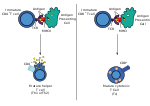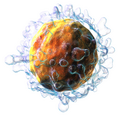Induced-self antigen is a marker of abnormal self, which can be recognized upon infected (in particular, virus-infected) and transformed cells. Therefore...
4 KB (534 words) - 08:30, 14 June 2022
antibody is called the antigen-antibody reaction. Antigen can originate either from within the body ("self-protein" or "self antigens") or from the external...
20 KB (2,435 words) - 08:54, 4 March 2024
Immune tolerance (redirect from Self-antigen)
induced by antigens given by mouth and exposed to the gut mucosa and its associated lymphoid tissues. The intestine harbours many non-self-antigens that...
50 KB (6,028 words) - 07:46, 12 July 2024
Cytotoxic T cell (redirect from Cytotoxic T-lymphocyte–associated antigen 4)
foreign antigen in the presence of self MHC. They will differentiate into either CD4+ or CD8+ depending on which MHC is associated with the antigen presented...
31 KB (3,843 words) - 08:24, 16 June 2024
antibodies to that specific antigen. Self-antigens are suppressed by regulatory T cells. Predicting which (fragments of) antigens will be presented to the...
51 KB (5,941 words) - 20:20, 27 June 2024
topics. Normal proteins in the body are not antigenic because of self-tolerance, a process in which self-reacting cytotoxic T lymphocytes (CTLs) and...
8 KB (863 words) - 13:17, 7 April 2024
Antigen-antibody interaction, or antigen-antibody reaction, is a specific chemical interaction between antibodies produced by B cells of the white blood...
19 KB (2,268 words) - 19:15, 23 November 2023
T-cell receptor (redirect from Alpha-beta T-cell antigen receptor)
recognizing fragments of antigen as peptides bound to major histocompatibility complex (MHC) molecules. The binding between TCR and antigen peptides is of relatively...
43 KB (5,372 words) - 15:31, 6 August 2024
Immunogenicity (redirect from Antigenicity)
Immunogenicity is the ability of a foreign substance, such as an antigen, to provoke an immune response in the body of a human or other animal. It may...
16 KB (1,812 words) - 23:41, 1 January 2024
An antigen-presenting cell (APC) or accessory cell is a cell that displays an antigen bound by major histocompatibility complex (MHC) proteins on its surface;...
16 KB (2,128 words) - 09:55, 4 March 2024
stage of antigen presentation pathways. This process involves two distinct pathways for processing of antigens from an organism's own (self) proteins...
12 KB (1,763 words) - 18:48, 6 April 2023
Major histocompatibility complex (redirect from MHC antigen)
function of MHC molecules: binding an antigen derived from self-proteins, or from pathogens, and bringing the antigen presentation to the cell surface for...
57 KB (6,750 words) - 08:09, 11 August 2024
Immunotoxicology Immunotoxin Immunotransplant Indoleamine 2,3-dioxygenase Induced-self antigen Inflammasome Inflammation Inflammatory reflex Innate immune system...
13 KB (1,237 words) - 01:24, 15 January 2024
Natural killer cell (redirect from Missing self)
drug-induced cell death in human triple-negative breast cancer. Since NK cells recognize target cells when they express nonself HLA antigens (but not self)...
74 KB (9,183 words) - 21:02, 10 August 2024
Activation-Induced Cell Death in T Cells and Autoimmunity. Cell Mol Immunol. 1(3):186-92 Kabelitz D, Janssen O. (1997), Antigen-induced death of T-lymphocytes...
3 KB (434 words) - 20:08, 23 October 2022
response induced by antigen-presenting cells of the recipient against the foreign MiHA cells. Because of this, Bevan implied that these antigen presenting...
17 KB (2,159 words) - 15:05, 5 June 2024
leukemia effect (GVL). The recognition of a mature T cell to this self antigen should not induce an immune response. During thymic selection occurring in the...
18 KB (1,681 words) - 12:56, 18 August 2023
T cell (section Antigen discrimination)
The thymocyte must also ensure that it does not react adversely to "self" antigens, called negative selection. If both positive and negative selection...
71 KB (9,026 words) - 12:33, 26 April 2024
Immune system (section Recognition of antigen)
system. Conversely, non-self molecules are those recognized as foreign molecules. One class of non-self molecules are called antigens (originally named for...
119 KB (13,494 words) - 08:00, 4 August 2024
cells recognize only fragmented antigens displayed on cell surfaces, antigen processing must occur before the antigen fragment can be recognized by a...
14 KB (1,665 words) - 02:58, 20 July 2024
reaction with eosinophilia and systemic symptoms (DRESS), also termed drug-induced hypersensitivity syndrome (DIHS), is a rare reaction to certain medications...
38 KB (4,291 words) - 02:57, 28 November 2023
Epitope (redirect from Antigenic determinants)
An epitope, also known as antigenic determinant, is the part of an antigen that is recognized by the immune system, specifically by antibodies, B cells...
21 KB (2,397 words) - 06:13, 26 February 2024
antibodies to foreign proteins (antigens) but not to human proteins (autoantigens). In some cases, antibodies to human antigens are produced; these are known...
54 KB (6,097 words) - 21:43, 28 June 2024
nsp3 and nsp4). This sequence encodes the protein of interest, used as an antigen in the case of vaccines or for protein replacement therapies. The gene...
8 KB (933 words) - 09:57, 9 August 2024
T helper cell (redirect from T-lymphocytes, helper-inducer)
Th1 cells requires interleukin-12-induced STAT4 transcription factor and ERK MAP kinase activation by high antigen dose". Immunity. 31 (2): 209–219. doi:10...
54 KB (6,597 words) - 14:51, 21 July 2024
the central nervous system (CNS). MICA plays the role of stress-induced self-antigen and serves as a ligand for the KLRK1/NKG2D killer activation receptor...
10 KB (1,266 words) - 23:26, 3 March 2023
Human leukocyte antigens (HLA) began as a list of antigens identified as a result of transplant rejection. The antigens were initially identified by categorizing...
45 KB (5,515 words) - 10:54, 4 January 2024
Gamma delta T cell (redirect from Gamma-delta T-cell antigen receptor)
and present antigens to αβ T cells. This leads to turn of naïve CD4+ and CD8+ αβ T cells into effector cells. The differentiation, induced by γδ T-APC...
35 KB (4,472 words) - 00:20, 13 June 2024
Molecular mimicry (redirect from Antigenic mimickry)
recognize self antigens as "self", is a loss of immunological tolerance, the ability for the immune system to discriminate between self and non-self. Other...
28 KB (4,099 words) - 05:30, 10 June 2024
subpopulation of T cells that modulate the immune system, maintain tolerance to self-antigens, and prevent autoimmune disease. Treg cells are immunosuppressive and...
79 KB (9,493 words) - 15:51, 21 June 2024














